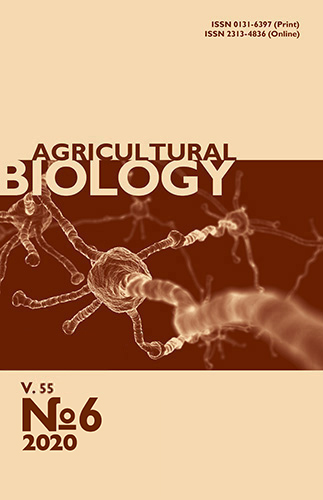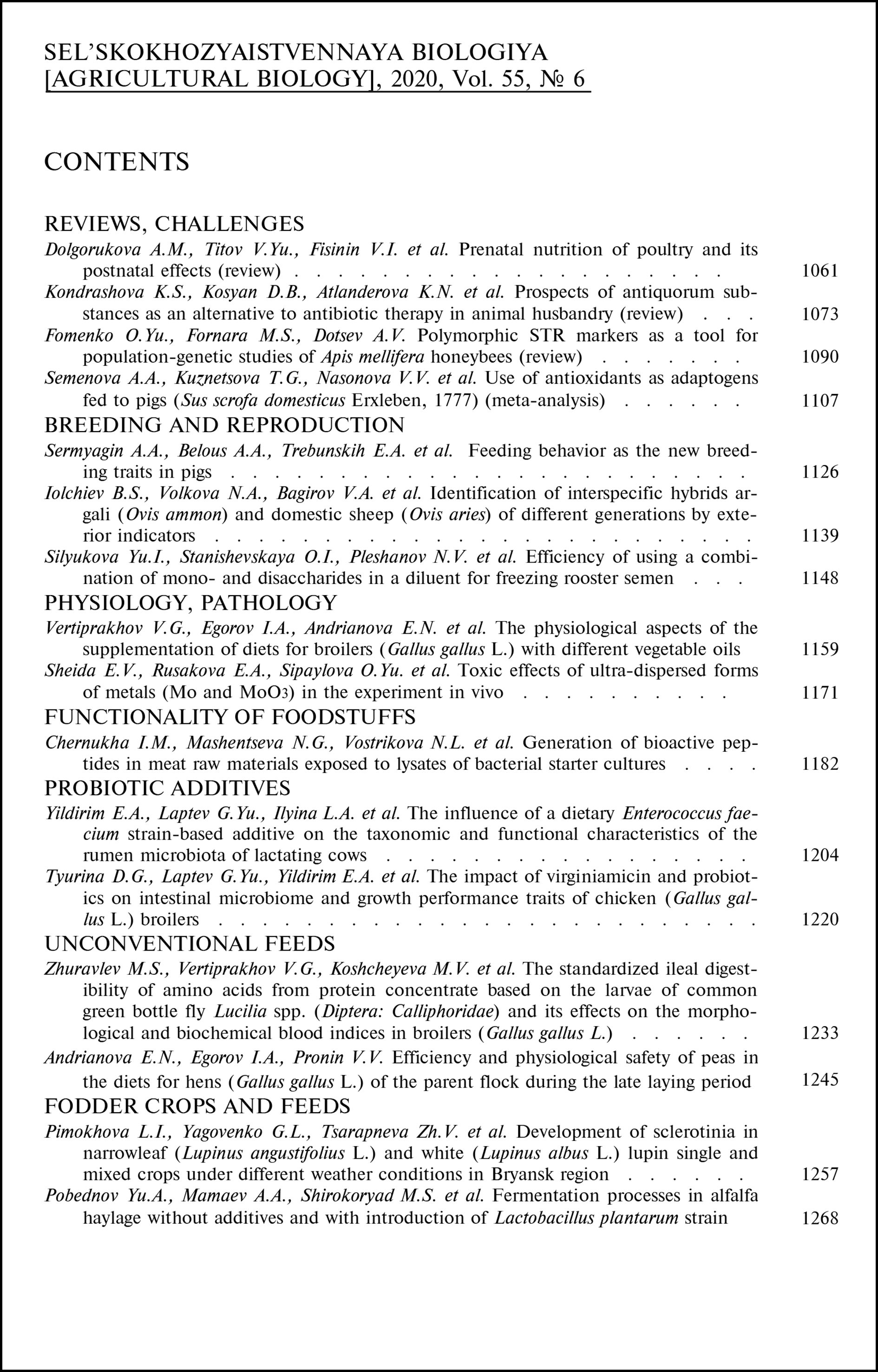doi: 10.15389/agrobiology.2020.6.1257eng
UDC: 633.367:632.4(470.333)
Acknowledgements:
Supported financially by the MSHE of the Russian Federation within the framework of the theme “To research species and population of the main forage crops’ pathogens and to develop methodology for field infection load creation. To identify new sources with increased field resistance to diseases” (the RAS Program for Fundamental Research, ААА-А18-118072590033-1)
DEVELOPMENT OF SCLEROTINIA IN NARROWLEAF (Lupinus angustifolius L.) AND WHITE (Lupinus albus L.) LUPIN SINGLE AND MIXED CROPS UNDER DIFFERENT WEATHER CONDITIONS IN BRYANSK REGION
L.I. Pimokhova, G.L. Yagovenko, Zh.V. Tsarapneva, N.V. Misnikova ✉
All-Russian Lupin Research Institute – Branch of the Federal Williams Research Center of Forage Production & Agroecology, 2, ul. Berezovaya, pos. Mitchurinskiy, Bryansk Province, 241524 Russia, e-mail lupin.fitopat@mail.ru, yagovenko@bk.ru, lupin_mail@mail.ru, lupin_nvmisnikova@mail.ru (✉ corresponding author)
ORCID:
Pimokhova L.I. orcid.org/0000-0002-9565-8176
Tsarapneva Zh.V. orcid.org/0000-0002-0311-5896
Yagovenko G.L. orcid.org/0000-0003-3205-230X
Misnikova N.V. orcid.org/0000-0001-5746-6539
Received July 9, 2020
White rot caused by ascomycetous fungus Sclerotinia sclerotiorum (Lib.)de Bary. is a widely spread disease of many cultivated and wild plants. In the Non Chernozem zone of Russia the epiphytotic development of white rot in white and narrowleaf lupin crops began in 2008 and is related to climate change towards warming. The article presents the first report on dependence between weather conditions in the Non Chernozem zone and white rot infection of white and narrowleaf lupines in single and mixed crops. High significant correlation coefficients have been obtained between air moisture and pods’ white rot infection of the narrowleaf lupin in June (r = 0.95, р = 0.001), and of the white lupin in June and July (r = 0.90, р = 0.006; r = 0.81, р = 0.026, respectively). High significant negative correlation coefficients between narrowleaf and white lupin yields in single and mixed crops and Sclerotinia infection of pods have been revealed (r = -0.92, р = 0.003 and r = -1.00, р = 0.002, respectively; r = -0.97, р = 0.000 and r = -0.88, р = 0.122, respectively). The lupin species differed in susceptibility to the pathogen. This work aimed to evaluate the white rot development and harmfulness in white and narrowleaf lupin crops depending on weather of the vegetation season and crop type under the conditions of Bryansk region. The narrowleaf lupin var. Belozernyi 110 and the white lupin var. Dega were cultivated in single crops and in mixed crops with spring wheat var. Iren in 2008-2012, 2014, and 2016 in the North-East of Bryansk region (an experimental field of All-Russian Lupin Scientific Research Institute). Climatic data were received from the meteorological station on the territory of the institute. Lupin plants were infected with white rot mycelium by the wet chamber method. Plants infection was evaluated during the vegetation period (stem and bud formation, flowering and pods’ formation stages). The yield of each plot was weighted after the total threshing (a combine-harvester Sampo-500, Sampo Rosenlew, Finland). Intensive pathogen development on the tested lupin species in single and mixed crops was in rainy and warm June-August, at 66.2-80.3 % air moisture. Under rainy, warm and windy conditions white rot spread among plants in lupin crops both by ascospores and by mycelium particles. The first lesion focuses appeared on stems in low field sites and in dense crops. Depressive disease development occurred at air moisture from 54.1 to 60.3 %. White lupin plants were more susceptible to the disease, probably due to the morphological peculiarities of this species. Under favorable conditions for the disease, the incidence of pod infection averaged 15.3-34.8 % in white lupin single crops and 8.4-34.7 % in narrowleaf lupin single crops. Herewith seed yield losses made 14.3-39.2 % and 3.0-34.7 %, respectively. Under dry conditions of 2010, the white lupin infection incidence was 0.3 % in mixed crops with no infection of the narrowleaf lupin observed. The infection of the narrowleaf and white lupins in their single crops made 0.1 and 1.3 %, respectively. The white rot was more harmful for lupin crops upon a combination of sufficient or excessive moisture and optimal temperature in the second part of vegetation. During this period, the pods were formed on the main and lateral stems, and the plant foliation was maximum too. The latter creates favorable conditions for the pathogen inside the crops. Pod infection in lupines decreased significantly in mixed lupin-and-cereal crops, 1.4-1.6-fold for the white lupin, and 1.3-2.3-fold for the narrowleaf lupin. Obviously, the lupin-and-cereal mixed crops create the conditions which are less favorable for the pathogen development and spread, therefore decrease infection of lupin plants and pods.
Keywords: Sclerotinia sclerotiorum, crop type, air moisture, harmfulness, Lupinus angustifolius L., narrowleaf lupin, Lupinus albus L., white lupin.
REFERENCES
- Yagovenko L.L., Misnikova N.V., Yagovenko G.L. Kormoproizvodstvo, 2012, 5: 13-16 (in Russ.).
- Mustafa M.A., Mayes S., Massawe F. Crop diversification through a wider use of underutilised crops: a strategy to ensure food and nutrition security in the face of climate change.In: Sustainable solutions for food security. A. Sarkar, S. Sensarma, G. van Loon (eds.). Springer, Cham, 2019: 125-149 CrossRef
- Yadav R.S., Yadav A.K. Isolation and evaluation of potent bio-control agent against Fusarium oxysporum f. sp. lentis, Sclorotium rolfsii and Sclerotinia sclerotiorum causing soil borne disease in lentil (Lens culinaris Medik). Int. J. Curr. Microbiol. App. Sci., 2019, 8(6): 715-721 CrossRef
- Andrianova E.N., Egorov I.A., Grigor'eva E.N., Shevyakov A.N., Pronin V.V. Lupine is applicable in diets for layer chicken of parental flock. Agricultural Biology [Sel'skokhozyaistvennaya biologiya], 2019, 54(2): 326-336 CrossRef
- Lizarazo C.I., Yli-Halla M., Stoddard F.L. Pre-crop effects on the nutrient composition and utilization efficiency of faba bean (Vicia faba L.) and narrow-leafed lupin (Lupinus angustifolius L.). Nutr. Cycl. Agroecosyst.,2015,103: 311-327 CrossRef
- Levitin M.M. Mikologiya i fitopatologiya, 2012, 46(1): 14-19 (in Russ.).
- Federal'naya sluzhba po gidrometeorologii i monitoringu okruzhayushchei sredy. Doklad ob osobennostyakh klimata na territorii Rossiiskoi Federatsii za 2015 god [Report on climate in the territory of the Russian Federation for 2015]. Moscow, 2016 (in Russ.).
- Mameev V.V., Nesterenko O.A. Materialy ХIV Mezhdunarodnoi nauchnoi konferentsii «Agroekologicheskie aspekty ustoichivogo razvitiya APK» [Proc. ХIV Int. Conf. «Agro-ecological aspects of sustainable development of agriculture»]. Bryansk, 2017: 81-85 (in Russ.).
- Hille J., Lambers R. Extinction risks from climate change. Science,2015, 348(6234): 501-502 CrossRef
- Pugnaire F.I., Morillo J.A., Peñuelas J., Reich P.B., Bardgett R.D., Gaxiola A., Wardle D.A., van der Putten W.H. Climate change effects on plant-soil feedbacks and consequences for biodiversity and functioning of terrestrial ecosystems. Science Advances, 2019, 5(11): eaaz1834 CrossRef
- Levitin M.M. Microorganisms and global climate chang. Agricultural Biology [Sel'skokhozyaistvennaya biologiya], 2015, 50(5): 641-647 CrossRef
- Kamesh Krishnamoorthy K., Sankaralingam A., Nakkeeran S. Effect of temperature and salinity on the growth of Sclerotinia sclerotiorum causing head rot of cabbage. Int. J. Curr. Microbiol. App. Sci., 2017, 6(2): 950-954 CrossRef
- Nazir N., Bilal Sh., Bhat K., Shah T., Badri Z., Bhat F., Wani T., Mugal M., Parveen Sh., Dorjey S. Effect of climate change on plant diseases. Int. J. Curr. Microbiol. App. Sci., 2018, 7(6): 250-256 CrossRef
- Trivedi Sh., Srivastava M.H., Srivastava A.K., Ratan V., Shahid Mo., Singh An., Pandey S., Dixit S., Srivastava Y.K. Status of root and foliar fungal diseases of pulses at different agro-climatic zones of Uttar Pradesh, India. Int. J. Curr. Microbiol. App. Sci., 2017, 6(11): 152-165 CrossRef
- Shahoveisi F., del Río Mendoza L.E. Effect of wetness duration and incubation temperature on development of ascosporic infections by Sclerotinia sclerotiorum. Plant Disease, 2020, 104(6): 1817-1823 CrossRef
- Wang B., Liu D.L., Evans J.P., Ji F., Waters C., Macadam I., Feng P., Beyer K. Modelling and evaluating the impacts of climate change on three major crops in south-eastern Australia using regional climate model simulations. Theor. Appl. Climatol., 2019, 138: 509-526 CrossRef
- Sanabria-Velazquez A.D., Testen A.L., Enciso G.A., Soilan L.C., Miller S.A. Effects of anaerobic soil disinfestation on Sclerotinia sclerotiorum in Paraguay. Plant Health Progress, 2019, 20(1): 50-60 CrossRef
- Juroszek P., von Tiedemann A. Potential strategies and future requirements for plant disease management under a changing climate. Plant Pathology, 2011, 60(1): 100-112 CrossRef
- Sharma P., Meena P.D., Singh S., Rai P.K. Efficacy of micro-nutrients, fungicides and bio-agents against sclerotinia stem rot (Sclerotinia sclerotiorum) of Indian Mustard. Int. J. Curr. Microbiol. App. Sci., 2017, 6(10): 620-626 CrossRef
- Peltier A., Hatfield R.D., Grau C.R. Soybean stem lignin concentration relates to resistance to Sclerotinia sclerotiorum. Plant Disease, 2009, 93(2): 149-154 CrossRef
- Wei W., Mesquita A.C.O., Figueiró A.d.A., Wu X., Manjunatha S., Wickland D.P., Hudson M.E., Juliatti F.C., Clough S.J. Genome-wide association mapping of resistance to a Brazilian isolate of Sclerotinia sclerotiorum in soybean genotypes mostly from Brazil. BMC Genomics, 2017, 18(849): 2-16 CrossRef
- Upadhyay N.K., Ratan V., Yadav V.K., Kumar A., Awasthi D., Chandra S., Rai J.P. Management of white mold fungus Sclerotinia sclerotiorum (Lib.) De Bary causes disease in tomato under in vitro conditions. Int. J. Curr. Microbiol. App. Sci., 2019, 8(8): 2733-2743 CrossRef
- Rather R.A., Nisar M.U., Raina Z.K., Ahanger F.A., Bhat N.A., Chesti F., Sofi P.A. Population structure of Sclerotinia sclerotiorum (Lib.) de Bary causing white mold of bean in Kashmir, India. Int. J. Curr. Microbiol. App. Sci., 2018, 7(9): 3795-3800 CrossRef
- Pawlowski M.L., Murithi H., Hailemariam M., Tesfaye A.A., Hartman G.L. First report of Sclerotinia sclerotiorum causing stem rot on soybean (Glycine max) in Ethiopia. Plant Disease, 2019, 103(10): 2676-2676 CrossRef
- Han I., Park K., Lee H., Lee S.-M., Shin J., Choi S.-L., Kim J. First report of Sclerotinia rot in sword bean caused by Sclerotinia sclerotiorumin South Korea. Plant Disease, 2020, 104(3): 988-988 CrossRef
- Gondran J., Bournoville R., Duthion C. Identification of diseases, pests and physical constraints in white lupin. INRA UNIP, Versailles, 1994.
- Champion R. Identifier les champignons transmis par les semences. INRA, Paris, 1997.
- Kaufmann K., Thalmann R., Pfeffer H., Schachler B., Stuck C. Resistance tests for soil-borne fungal diseases in narrow-leafed lupin (Lupinus angustifolius L.) Proc. 13th International Lupin Conference «Lupin crops — an opportunity for today, a promise for the future», 6-10 June, 2011, Poznan, Poland. B. Naganowska, P. Kachlicki, B. Wolko (eds.). New Zealand, Canterbury, ILA, 2011: 269-271.
- Dorozhkin N.A., Chekalinskaya N.I. Bolezni lyupina [Diseases of lupine plants]. Minsk, 1965 (in Russ.).
- Korneichuk N.S. V sbornike: Povyshenie urozhainosti sel'skokhozyaistvennykh kul'tur na peschanykh pochvakh Poles'ya. Kiev, 1971: 115-126.
- Takunov I.P. Lyupin v zemledelii Rossii [Lupin in Russian agriculture]. Bryansk, 1996 (in Russ.).
- Bettkher I., Vettsel' T., Dreve F., Kegler X., Naumann K., Fraier B., Frauenshtain K., Fuks E. Metody opredeleniya boleznei i vreditelei sel'skokhozyaistvennykh rastenii [Methods for determining diseases and pests of agricultural plants]. Moscow, 1987 (in Russ.).
- DospekhovB.A. Metodika polevogo opyta [Methods of field trials]. Moscow, 1985 (in Russ.).
- Simic B., Cosic J., Popovic R., Vrandecic K. Influence of climate conditions on grain yield and appearance of white rot (Sclerotinia sclerotiorum) in field experiments with sunflower hybrids. Cereal Research Communications, 2008, 36: 63-66.
- Luong T.M., Huynh L.M.T., Le T.V., Burgess L.W., Phan H.T. First report of Sclerotinia blight caused by Sclerotinia sclerotiorum in Quang Nam, Vietnam. Australasian Plant Disease Notes, 2010, 5: 42-44 CrossRef












